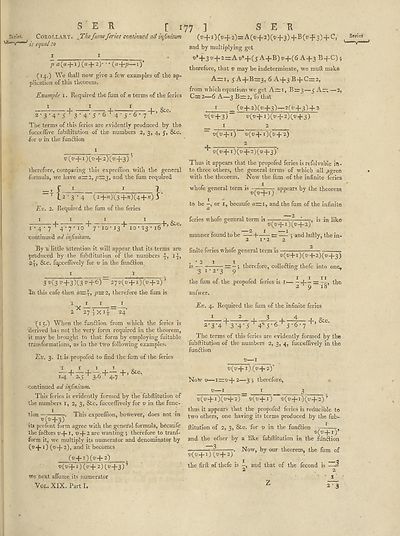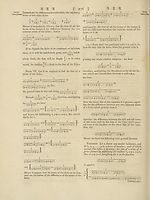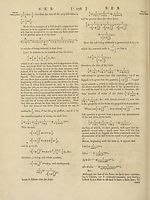Encyclopaedia Britannica, or, a Dictionary of arts, sciences, and miscellaneous literature : enlarged and improved. Illustrated with nearly six hundred engravings > Volume 19, Scripture-SUG
(187) Page 177
Download files
Complete book:
Individual page:
Thumbnail gallery: Grid view | List view

S E R [I
Si i*es. Corollary. The fame feries continued ad infinitum
7 is equal to
i 5
p fi (a-|-x) («-{” 2)' ’' i)*
(14.) We flball now give a few examples of the ap»
plication of this theorem.
Example 1. Required the futn of n terms of the feries
—j ■■ ^ Sec#
2 ‘ 3 • 4 ' i' 3 ' 4 ‘ 5 ‘ ^ 4 ‘ 5 ’ ^ ‘ 7
Tlie terms of this feries are evidently produced by the
fucceflive fubftitution of the numbers 2, 3, 4, 5, &c.
-for v in the function
2)04-3) ’
therefore, comparing this expreffion with the general
formula, we have a—2,p~^^ and the fum required
r .1 7
t72'3'4 (2_f-,i)(3+n)(4+n)-t
Ex. 2. Required the fum of the feries
1 + 1
77 ] S E R
(t>^i)04#2)=:A0-f 2)0+3)+BO-f 3)4-C,
and by multiplying get
^* + 3 ^ + 2=A i>*4-(5 A-}-B)^+(6 A-f3 B-j-C) j
therefore, that v may be indeterminate, we mud make
A—1, 5 A-f-Br=3, 6 Aq*3 B-f-C^ra,
from which equations we pet Arri, B7— c Arr; —2,
2—6 A—£ B:z=2, fo that
1 _ (-^42)(i'-f3)—20+3)4-2
^0+3) ^0+00+2)0+3)
I 2
~ ^0+0 ‘»(‘U+l)(u+2)
+ 1 .
*>0+00+2)0+3)
Thus it appears that the propofed feries is refolvable in.
to three others, the general terms of which all .agree
with the theorem. Now the fum of the infinite feries
whofe general term is —- appears by the theorem
to be -, or 1, becaufe a=zi, and the fum of the infinite
a
~2
+, &c.
feries whofe general term is
i-q-y 4*7’io 7,io,i3 io*I3’x6
continued ad infinitum.
By a little attention it will appear that its terms are
produced by the fubftitution of the numbers + 1+
2j, &c. fqpceflively for v in the fundtion
©0 + I)0+'2)
, is in like
3 K3 t;+3)C3 2’4-6) 27u(u+1)0+2) ?
Bi this cafe then a~:+ p— 2, therefore the fum is
r 1 1
24’
2 2 7 t X 14
manner found to be “ + ^ ’ anc^ ^iBy, the in-
2
finite feries whofe general term is — -7
©0+1)0+2)0+3)
. " 2 t I
is — -—— =r — ; therefore, colledtin^ thefe into one.
3 1 • 2* 3 9 7
the fum of the propofed feries is I— -4-- = the
1 x 9 18’
anfwer.
Ex. 4. Required the fum of the infinite feries
(15.) When the fundtion from which the feries is
derived has not the very form required in the theorem,
it may be brought to that form by employing fuitable
transformations, as in the two following examples.
Ex. 3. It is propofed to find the fum of the feries
1 r 1 1 0
f f“”2+ +’
1.4 1 2. ^ 1 3-6 4.7
continued ad infinitum.
This feries is evidently formed by the fubftitution of
the numbers 1, 2, 3, &c. fucceflively for v in the func¬
tion ——^—-. This exprefiion, however, does not in
©0+3)
its prefent form agree with the general formula, becaufe
the factors ©+1, © + 2 are wanting •, therefore to tranf-
form it, we multiply its numerator and denominator by
(©+1) 0 + 2), and it becomes
0+00+2)
©0+00+2)0+3)*
we next aflume its numerator
Vol. XIX. Part I.
+, &c.
2* 3 "4 3 ’4'5 4 s 5 *6 S’6'1
The terms of this feries are evidently formed by the
fubftitution of the numbers 2, 3, 4, fucceftively in the
fundtion
©(©+1) (©+ 2)”
NoW ©—1=:©+2—3 •, therefore,
©—1 1
©O+1)0+ 2) ©(©+1) ©0+OO+2) ’
thus it appears that the propofed feries is reducible to
two others, one having its terms produced by the fub¬
ftitution of 2, 3, &c. for © in the fundtion -—-—
©O+i)
and the other by a like fubftitution in the fundtion
3
Now, by our theorem, the fum of
©0+0 0+2)
-3
the firft of thefe is -, and that of the fecond is
2 2
* * I '
Serlet
l.
Si i*es. Corollary. The fame feries continued ad infinitum
7 is equal to
i 5
p fi (a-|-x) («-{” 2)' ’' i)*
(14.) We flball now give a few examples of the ap»
plication of this theorem.
Example 1. Required the futn of n terms of the feries
—j ■■ ^ Sec#
2 ‘ 3 • 4 ' i' 3 ' 4 ‘ 5 ‘ ^ 4 ‘ 5 ’ ^ ‘ 7
Tlie terms of this feries are evidently produced by the
fucceflive fubftitution of the numbers 2, 3, 4, 5, &c.
-for v in the function
2)04-3) ’
therefore, comparing this expreffion with the general
formula, we have a—2,p~^^ and the fum required
r .1 7
t72'3'4 (2_f-,i)(3+n)(4+n)-t
Ex. 2. Required the fum of the feries
1 + 1
77 ] S E R
(t>^i)04#2)=:A0-f 2)0+3)+BO-f 3)4-C,
and by multiplying get
^* + 3 ^ + 2=A i>*4-(5 A-}-B)^+(6 A-f3 B-j-C) j
therefore, that v may be indeterminate, we mud make
A—1, 5 A-f-Br=3, 6 Aq*3 B-f-C^ra,
from which equations we pet Arri, B7— c Arr; —2,
2—6 A—£ B:z=2, fo that
1 _ (-^42)(i'-f3)—20+3)4-2
^0+3) ^0+00+2)0+3)
I 2
~ ^0+0 ‘»(‘U+l)(u+2)
+ 1 .
*>0+00+2)0+3)
Thus it appears that the propofed feries is refolvable in.
to three others, the general terms of which all .agree
with the theorem. Now the fum of the infinite feries
whofe general term is —- appears by the theorem
to be -, or 1, becaufe a=zi, and the fum of the infinite
a
~2
+, &c.
feries whofe general term is
i-q-y 4*7’io 7,io,i3 io*I3’x6
continued ad infinitum.
By a little attention it will appear that its terms are
produced by the fubftitution of the numbers + 1+
2j, &c. fqpceflively for v in the fundtion
©0 + I)0+'2)
, is in like
3 K3 t;+3)C3 2’4-6) 27u(u+1)0+2) ?
Bi this cafe then a~:+ p— 2, therefore the fum is
r 1 1
24’
2 2 7 t X 14
manner found to be “ + ^ ’ anc^ ^iBy, the in-
2
finite feries whofe general term is — -7
©0+1)0+2)0+3)
. " 2 t I
is — -—— =r — ; therefore, colledtin^ thefe into one.
3 1 • 2* 3 9 7
the fum of the propofed feries is I— -4-- = the
1 x 9 18’
anfwer.
Ex. 4. Required the fum of the infinite feries
(15.) When the fundtion from which the feries is
derived has not the very form required in the theorem,
it may be brought to that form by employing fuitable
transformations, as in the two following examples.
Ex. 3. It is propofed to find the fum of the feries
1 r 1 1 0
f f“”2+ +’
1.4 1 2. ^ 1 3-6 4.7
continued ad infinitum.
This feries is evidently formed by the fubftitution of
the numbers 1, 2, 3, &c. fucceflively for v in the func¬
tion ——^—-. This exprefiion, however, does not in
©0+3)
its prefent form agree with the general formula, becaufe
the factors ©+1, © + 2 are wanting •, therefore to tranf-
form it, we multiply its numerator and denominator by
(©+1) 0 + 2), and it becomes
0+00+2)
©0+00+2)0+3)*
we next aflume its numerator
Vol. XIX. Part I.
+, &c.
2* 3 "4 3 ’4'5 4 s 5 *6 S’6'1
The terms of this feries are evidently formed by the
fubftitution of the numbers 2, 3, 4, fucceftively in the
fundtion
©(©+1) (©+ 2)”
NoW ©—1=:©+2—3 •, therefore,
©—1 1
©O+1)0+ 2) ©(©+1) ©0+OO+2) ’
thus it appears that the propofed feries is reducible to
two others, one having its terms produced by the fub¬
ftitution of 2, 3, &c. for © in the fundtion -—-—
©O+i)
and the other by a like fubftitution in the fundtion
3
Now, by our theorem, the fum of
©0+0 0+2)
-3
the firft of thefe is -, and that of the fecond is
2 2
* * I '
Serlet
l.
Set display mode to:
![]() Universal Viewer |
Universal Viewer | ![]() Mirador |
Large image | Transcription
Mirador |
Large image | Transcription
Images and transcriptions on this page, including medium image downloads, may be used under the Creative Commons Attribution 4.0 International Licence unless otherwise stated. ![]()
| Permanent URL | https://digital.nls.uk/192697713 |
|---|
| Attribution and copyright: |
|
|---|
| Description | Ten editions of 'Encyclopaedia Britannica', issued from 1768-1903, in 231 volumes. Originally issued in 100 weekly parts (3 volumes) between 1768 and 1771 by publishers: Colin Macfarquhar and Andrew Bell (Edinburgh); editor: William Smellie: engraver: Andrew Bell. Expanded editions in the 19th century featured more volumes and contributions from leading experts in their fields. Managed and published in Edinburgh up to the 9th edition (25 volumes, from 1875-1889); the 10th edition (1902-1903) re-issued the 9th edition, with 11 supplementary volumes. |
|---|---|
| Additional NLS resources: |
|

